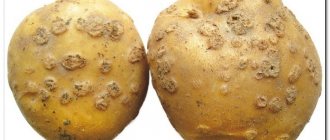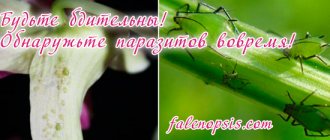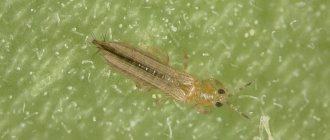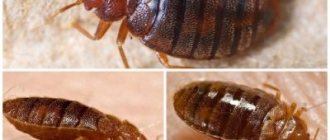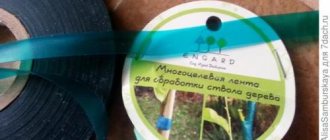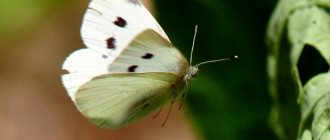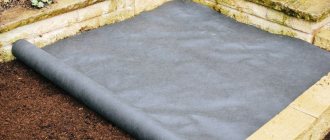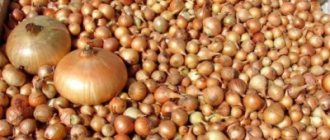Home / Pests and diseases
Back
Published: 07/03/2019
Reading time: 8 min
0
How a gardener rejoices when he sees the strong emerald green feathers of onion seedlings in the garden. But the picture changes dramatically when a dangerous onion fly appears in the garden, the larvae of which instantly attack and destroy the plantings. How to fight it and prevent the appearance of insects on the site?
- 1 Description of the pest
- 2 Signs of the appearance of onion flies in the beds
- 3 Prevention of onion fly occurrence
- 4 Pest control methods 4.1 Traditional recipes
- 4.2 Application of insecticides
Description of the pest
The body of the insect is 6–10 mm long and gray with a greenish tint on the back. The pest has black legs and transparent wings.
On the abdomen of males, unlike females, there is a dark longitudinal stripe. Their eyes are located close together, and in females they are separated by the forehead.
The body of the larvae is white, cylindrical, up to 10 mm long. The larva has no distinct head and no legs. The body is narrowed towards the anterior end; a black mouth opening is located here. The abdomen is sloping at the back, and 16 conical tubercles are visible on the anal area. The larvae retain these tubercles when they develop into shiny red-brown pupae (puparia).
The pest lays white eggs, 1–2 mm in size, pointed at one end and blunt at the other.
You need to know the enemy by sight
The onion fly is an inconspicuous gray insect, up to 10 mm in length. The male has a dark stripe on its abdomen.
Females lay up to 60 eggs on leaves or bulbs raised above ground level.
It is possible to determine that a bulbous plant is affected by this pest purely visually. In onions, the first sign is yellowing of the feathers, their lethargy and drying out. It is also necessary to pay attention to the smell emanating from the onion. If it has become uncharacteristic for the plant, then this is a serious cause for concern.
You can make sure that the onion is damaged by the pest by digging the bulb itself out of the ground. If there is plaque on it, then over time it will become soft and unsuitable for food.
A week after this, larvae appear and live off the plant. After pupation, the insect moves on to the next form - a flying insect.
The onion fly is a dangerous pest in the garden; how can you fight it if it starts flying in April? Pre-treatment before planting and spraying will come to the rescue.
Life cycle
The full development cycle lasts 45–80 days and goes through 4 stages: egg, larva, pupa, imago (adult). The pest appears in late April - mid-May during the flowering of lilac and cherry trees. At this time, the bow already has 2-3 feathers. Mating occurs immediately after departure and within a week the females lay their first eggs.
On lumps of earth, around the base of leaves or under dry scales of bulbs, they leave heaps of 5–20 eggs for 2 weeks. Females are fertile, capable of laying 60–200 eggs . The embryo in the egg develops in 3–8 days. The emerging larvae are voracious and quickly bore into the bulbs. In search of food they can move from one plant to another.
The pest remains in the larval phase for 15–20 days. During this time, 4–5 molts occur. As the larvae grow, the upper skin does not stretch much, so the pest sheds it several times.
The time intervals between molts are called instars, each of them lasts 3–4 days. Immediately after molting, the larva's body is tender and vulnerable. The development of larvae is affected by air temperature. The higher it is, the faster this process occurs.
After the last molt, the larvae enter the pupal stage. This is the transitional stage of a larva into an adult insect. Pupation occurs in the ground under plants at a depth of 3–7 cm. The pupae are motionless, but a serious restructuring is taking place in their body.
After 2–3 weeks, the fully formed adult fly breaks through the cocoon, comes out and spreads its wings. He does not leave his place immediately, but as soon as his body gets stronger. Second generation onion flies appear in July . Adults live 12–30 days; to lay eggs, females gain strength from the nectar of flowers.
The pest overwinters in the pupal stage in the ground at a depth of 10–20 cm. Depending on the climatic region, 1–3 generations of insects appear in just one season .
Reviews from gardeners
Evgeniy, 53 years old, Krasnodar
In the spring, tulip bulbs were planted in the summer cottage. After a while, we noticed that the leaves on the flowers turned yellow and dried out. The housemates suggested a very simple recipe: a glass of salt per ten liters of water. The resulting solution was used to water the tulips affected by the onion fly, as well as the daffodils - each of them received approximately a glass of salt solution. However, after watering, the soil began to become salty, and the flowers in the flowerbed subsequently grew much worse. To stop the salting, the next day after watering they repeated it again, but used ordinary rather than salted water.
Igor, 48 years old, Rostov region
The onion midge was completely defeated only after transplanting the onion to a new place. And before that, for some time, the solution that we prepared ourselves worked well: we took 0.5 teaspoon of boric acid, 3 drops of iodine and 1 tablespoon of ammonia and diluted it in 10 liters of water. 250 ml of solution was poured under each plant. Before planting, onion sets were soaked for 5 minutes in a light pink solution of potassium permanganate, then dried.
Dmitry, 50 years old, Bryansk
From personal experience I will say that the onion fly does not tolerate strong odors, so I plant lovage or wild rosemary next to the onion beds. To be precise, midges will never lay eggs close to these plants. In May, when the pest is not yet particularly active, I treat it with an infusion of dandelion roots (200 g per 10 liters of water) no more than once a week.
Signs of onion infection
Onion fly larvae
The most dangerous thing for plants ; they do the most damage. They penetrate into the pulp of the bulb through the base of the leaves or from the bottom. They gnaw out large areas, forming passages .
In onions, larvae from one oviposition usually feed on one bulb; in onion sets, they move to neighboring ones and eat away large cavities in the head. With a severe infection, more than 50 larvae can colonize the bulb. The larvae of the first generation destroy early varieties in June, the second - plants in July-August.
In the garden, at the first sign, it is noticeable that the plants are targeted. The feathers of such an onion turn yellow, wither and fold in half, and then dry out . If the plant is pulled out of the ground, you will see that the bulb has softened, is covered with a coating of mold, and the bottom is occupied by small white worms . Damage allows fungal infections to enter the tissue. Infected bulbs rot, and in wet weather this happens faster and smells unpleasant.
In addition to onions, the pest colonizes garlic if it is grown continuously for several years in the same place. The onion fly damages tulip bulbs , as well as carnations, delphiniums, and phlox .
How to deal with larvae
Onion fly larvae are destroyed very effectively by anti-helminth drugs. To prepare the composition, you need to take 5 tablets of any drug, such as Pirantel, Wormila or Albendazole and dissolve them in 10 liters of warm water. After this, you can process any plants. Sand with mothballs in a ratio of 10:1 also effectively destroys larvae.
The onion fly dies immediately if you treat onions with this! How to treat onions against onion flies?
Reasons for the appearance of the pest on the site
The onion fly prefers loam and sandy loam soils, and is less common on peat bogs. Loves beds fertilized with fresh manure.
The pest settles in areas where onions and garlic have been continuously grown for many years. The problem is aggravated by the lack of autumn tillage. Since the pupae remain in the ground for the winter, pre-winter deep digging will help destroy some of the larvae that are on the soil surface.
The number of pests is affected by weather conditions. With sharp spring warming, the activity of onion flour increases. In a wet, cold spring, the harmfulness is reduced, since adult individuals appear later, egg laying and the appearance of larvae are delayed.
The pest may appear on the site when planting onion sets that are infected or not pre-treated.
How to get rid of onion fly
Chemical and biological drugs
Strong chemicals will be needed when the pest appears en masse and over large areas. The onion fly damages plants both in open ground and in greenhouses. If you notice it in time, you can do without chemicals or immediately destroy the affected specimens.
In the larval phase, chemicals penetrate well into the delicate skin of the pest. At this stage, contact treatments will be effective. But processed vegetables are only suitable for eating after 2–3 weeks. It is not recommended to spray onion feathers with chemicals.
Aktara VDG
Plants are sprayed against onion flies with a solution prepared from 4 g of the drug and 10 liters of water. The granules are dissolved in warm water (temperature should not be lower than 25°C).
This volume is designed to process 10 square meters. m. The onions are sprayed for the first time when the dandelions begin to bloom, and after 1–1.5 months the plants are sprayed again.
Alatar CE
The dosage of the drug for pest control is 5 ml per 4 liters of water. The beds with onions and garlic are processed in the morning or evening in dry weather no more than 2 times per season.
Corado
Systemic drug for the destruction of adult onion flies and their larvae. Does not lose its properties in dry hot weather and is not washed off by rain.
The onions are processed for the first time before planting. The seedlings are sprayed with a solution prepared from 15 ml of the drug and 0.2 liters of water. This volume is consumed for 10 kg of sets.
The onion is sprayed a second time when 3-4 feathers grow. The concentration of the drug is 2 ml per 2 liters of water. The solution consumption is 1 liter per 1 hundred square meters.
Summer resident
Biological preparation from Siberian fir extract. Harmless to humans, animals, bees, does not pollute the soil. It is used for spraying.
5 ml of the product is diluted in 8 liters of water. The solution does not lose its properties in cool and rainy weather. But a one-time treatment will not give results. Onions will need to be sprayed at least 3 times.
ExtraFlor
A preparation based on tobacco extract to protect plants from many insect pests, including onion flies. Helps to grow environmentally friendly and healthy vegetables. The contents of the package (1 g) are poured into 1 liter of warm water, mixed and the liquid is allowed to cool. Before use, the solution is filtered.
Fly eater
Diazinon-based insecticide for killing adult flies and their larvae in the soil. For pest control, it is used once before planting onions.
In calm, dry weather, granules are scattered over the soil surface at the rate of 50 g per 10 square meters. m. Then the beds are loosened. Pests die within 2–3 days after the drug enters their body. The protective effect lasts 2 months.
Zemlin
Preparation for soil application. It is scattered over the top layer and at the same time loosened the ground. The consumption rate of the product is 3 g per 1 sq. m. It protects against onion flies for 20 days.
Sochva J
The drug repels the onion fly and does not allow it to settle in the treated area. It is produced in liquid form, it is a concentrate of wood smoke. When using a concentrate, plants are less damaged - by 50%-90%.
5 ml of the drug is mixed with 1.5 liters of water and sprayed onion feathers 2-3 times. The break between treatments is 7 days. The consumption rate of the working solution is 5 liters per 1 sq.m.
Traditional methods
- Onion flies, which appear in the spring, are inactive, fly slowly and sometimes get indoors. If the planting area is small, they can be easily caught by hand or with a net.
- The onion fly is sensitive to odors. To protect plants, solutions are prepared from fragrant herbs, ash, and ammonia. These methods will be effective if applied systematically and immediately after planting the onions.
- Tobacco in its pure form or mixed with ash and ground pepper is scattered along the rows (1–2 kg per 10 sq. m.), and then the soil is loosened. Solutions for spraying are prepared from tomato tops, wormwood, and chamomile. You can place the chopped stems of these plants in the rows. After a week, the wilted tops are replaced with fresh ones.
- The insect cannot stand the smell of tar. Before planting, the bulbs are soaked for 2 hours in a tar solution: 10 g are dissolved in 1 liter of water. The tar smell when spraying onion leaves will repel insects. The crop is treated during the egg laying period. The solution is prepared from 20 g of tar and 10 liters of water. The procedure is carried out 2-3 times with a break of 10-14 days.
- Water the damp soil with a solution of ammonia. 1–2 tbsp. l mixed with 10 l of water. The nitrogen contained in the solution will feed weakened plants and prevent yellowing of the feather tips.
- An old way to combat the pest is to water the soil with saline solution. 200 g of table salt are dissolved in 10 liters of water. The solution is used only on moistened beds. After treatment, they are watered again with clean water. The saline solution is used once per season. They cannot constantly cultivate the soil, otherwise salinization cannot be avoided.
Pest control in a greenhouse
People who grow vegetables often encounter this insect. After the onion fly settles on the plant, the onion feathers immediately turn yellow. If green onions are grown in a greenhouse for sale, then this situation immediately causes concern. Indeed, with a large number of pests, a significant part of the harvest can be lost.
You can prevent the invasion of pests into the greenhouse by using nitrogen fertilizing. And if insects have already been discovered, then you need to immediately carefully remove the damaged plant from the soil and lower the bulb into water - the larvae will soon die. This procedure is effective only when the larvae have not yet turned into pupae. If you do not deal with them in time, young flies will soon appear.
Onion flies pose a serious threat to crops of the onion family. However, protecting plants from pests in garden beds or in a greenhouse is a completely doable task. Correct implementation of pest control recommendations will allow you to get a high onion harvest on time.
Is it true that the onion fly does not like the smell of carrots, but onions repel the carrot fly?
Planting these vegetables together repels pests. The onion fly does not like the smell of carrots, and onion phytoncides repel the carrot fly. When planting together, you need to take into account that onions ripen earlier and 2 weeks before harvesting they stop watering them so that the bulbs ripen in dry soil. Carrots still need a lot of moisture at this time. Therefore, it is better to plant crops without alternating rows, but by dividing the bed lengthwise into 2 parts . On one side, onions are planted, and on the other, carrots.
Prevention
- Maintaining crop rotation. The onion is returned to its original place no earlier than after 3 years.
- Planting and sowing early so that the onion has time to get stronger by the time the insect flies. The planting material is pre-etched. To speed up the growth of the heads, at the end of May the plants are fed with urea.
- The soil around the crops is mulched with compost, peat or a mixture of them with crushed coniferous or pine litter. Loose soil makes it more difficult for insects to lay eggs.
- At the first sign of a pest, infected bulbs are pulled out and destroyed.
- In autumn, plant debris is removed from the site, and the soil is dug up deeply.
These measures will not give the pest the opportunity to take over the site and will help to grow onions healthy and without losses.
More details: you will learn how to deal with onion flies from the video.
Preventive measures
Preventive measures are aimed at preventing plant infection. The main recommendation is to change the location for the onion every three years. Before planting, onion seedlings should be soaked for ten minutes in a heated solution of potassium permanganate. At the end of spring, it will not be superfluous to treat the soil with insecticides.
In addition, fertilizer mixtures based on peat, manure and peat must be added to the soil. To prevent midges from approaching the plantings, the seedlings should be treated with bitter compounds based on wormwood, tansy or pepper. After harvesting, the soil must be dug up so that the larvae die from the cold.
Share link:
